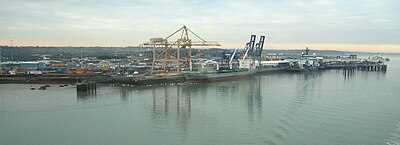Harwich International Port
| Harwich International Port | |
|---|---|
 2007 view of Harwich International Port from the north-east | |
 | |
| Location | |
| Location | River Stour, Essex, England |
| Coordinates | 51°56′53″N 1°15′18″E / 51.948°N 1.255°ECoordinates: 51°56′53″N 1°15′18″E / 51.948°N 1.255°E |
| Details | |
| Opened | 1883 (as Parkeston Quay) |
| Owned by | Hutchison Port Holdings |
| Type of harbor | Seaport |
| Land area | 105 acres (0.42 km2) |
| Available berths | 4 |
| Rail lines | Mayflower |
| Statistics | |
| Website www | |
Harwich International Port is a North Sea seaport in Essex, England, and one of the Haven ports. It lies on the south bank of the River Stour one mile upstream from the town of Harwich, opposite the Port of Felixstowe. The port was formerly known as Parkeston Quay.
History[]

The Great Eastern Railway, which was formed from the merging of the Eastern Counties Railway and the Eastern Union Railway in 1862, operated passenger steamers across the North Sea from Harwich to continental Europe. By 1872, shipping trade had increased so that more capacity was required and the Great Eastern Railway obtained permission to reclaim land at Ray Farm, a mile to the west of Harwich, and build a new quay. This new quay was opened in 1883 by Charles H. Parkes, the Chairman of the Great Eastern Railway company, the port being named after him as Parkeston Quay. The port had its own railway station, and a hotel was built between the northern platform and the quay; the hotel building is now used as offices. The railway station was originally called Parkeston Quay,[1] but was renamed Harwich Parkeston Quay in 1934[2] when the new Parkeston Quay West station was opened to serve the west end of the quay.[3] It was given its current name, Harwich International, in 1995.[4]
The port remained under the ownership of the Great Eastern Railway until 1923 when the company became part of the London and North Eastern Railway (LNER). In 1939 the Admiralty requisitioned Parkeston Quay for naval purposes, naming it HMS Badger. It was released back to the LNER in 1946.
On 1 January 1948 the LNER was nationalised and the port came under the ownership of British Railways (BR). In 1984, as part of the privatisation of BR's Sealink ferry services, the port was sold to Sealink's new owners Sea Containers, which sold it on to Stena Line in 1989.[5] In 1997 Parkeston Quay was acquired by Hutchison Port Holdings, which renamed the port Harwich International Port.[6]

Current operations[]


The main user of the port is the regular ferry services of Stena Line who run twice daily passenger and freight services to the Hook of Holland; as well as freight only services to Rotterdam Europort. The main vessels serving the port are the RoPax ferries the Stena Hollandica and the Stena Britannica, and the RoRo ferries.
Previously, DFDS Seaways operated services to Esbjerg, Denmark (ceased 29 September 2014),[7] Cuxhaven (and before that to Hamburg), Germany, and Gothenburg, Sweden; the latter two services were discontinued by 2005.[8][9]
Cruise ships once called regularly at the port during the summer months, although in recent times these calls have become more and more infrequent. The year 2016 saw 12 visits – the lowest since the service started. While the majority of opinion puts this down to the recent economic downturn, others feel the reason is due to the lack of facilities for visitors when compared to the likes of Southampton or Dover. Tankers call at the Carless refinery, and some general cargo and bulk cargos are worked at the port.[citation needed]
As of May 2010, the port was the base for the installation of the offshore Greater Gabbard wind farm[10] and Thanet Wind Farm in the southern North Sea, and has also been used for Gunfleet Sands Offshore Wind Farm.[11]
The operations and maintenance base for the Galloper wind farm is housed in the port and is made up of a dedicated pontoon, warehouse and office space.
Facilities[]
There are four[12] ro-ro berths with linkspans. The specialised pier for the High Speed Ferry Discovery is disused now that the high-speed ferry service has been discontinued and its linkspan has been removed. There are extensive railway sidings adjacent to and within the port with 40 acres of standing for cars including electric vehicle charging points. In total, there are over 105 acres (0.42 km2) of operational land with parking for over 1,000 trailers.
References[]
Notes[]
- ^ Allen, Cecil J. (1955). The Great Eastern Railway. Shepperton: Ian Allan Ltd. p. 193. ISBN 0-7110-0659-8.
- ^ Mitchell, Vic (June 2011). Branch Lines to Harwich and Hadleigh. Midhurst: Middleton Press. plate 61. ISBN 978-1-908174-02-4.
- ^ Mitchell 2011, plate 48
- ^ Mitchell 2011, plate 76
- ^ "The Great British Rail Sale is Over" The Railway Magazine issue 1152 April 1997 page 24
- ^ History Hutchison Ports
- ^ "Harwich to Esjberg - Ferry to Scandinavia - DFDS". www.dfdsseaways.co.uk.
- ^ "England-Fähre eingestellt" [England ferry discontinued]. Hamburger Abendblatt (in German). 8 November 2005. Retrieved 26 January 2016.
- ^ "DFDS Annual Report 2005" (PDF). Retrieved 14 March 2014.
- ^ Offshore wind handled at Harwich Breakbulk, 21 May 2010. Retrieved: 18 August 2010.
- ^ Harwich and offshore wind farms Offshore Wind, 19 April 2010. Retrieved: 18 August 2010.
- ^ Ro-Ro 5 was removed in 2007
Bibliography[]
- Brown, Stephen (2014). Harwich Ferries: Parkeston Quay under railway ownership. Ramsey, Isle of Man: Ferry Publications. ISBN 9781906608866.
- Hendy, John; Cowsill, Miles; Brown, Stephen (2010). Harwich–Hook of Holland, 1893–2010. Ramsey, Isle of Man: Ferry Publications. ISBN 9781906608101.
External links[]
| Wikimedia Commons has media related to Harwich International Port. |
- Ports and harbours of Essex
- Ports and harbours of the North Sea
- Harwich
